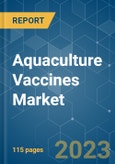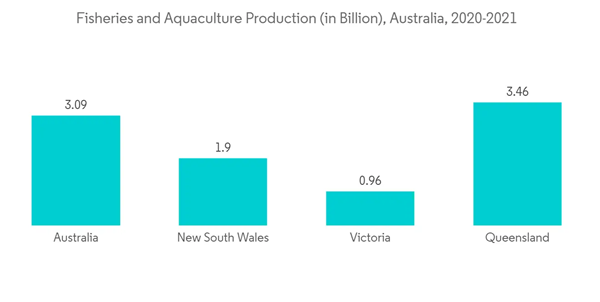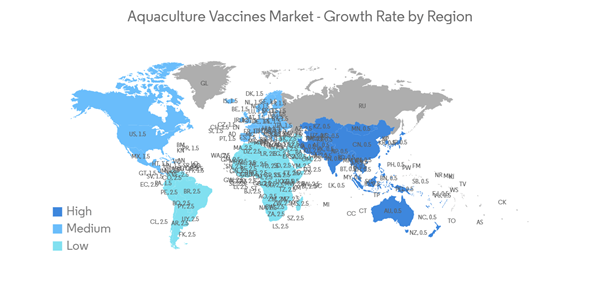During the time frame of the forecast, the aquaculture vaccines market is expected to register a CAGR of 6.2%. The COVID-19 pandemic had a significant impact on the animal industry, as due to the lockdown there was a significant impact on the logistics and supply chain of not only the essential pharmaceutical products for animals but also feed and other food items for animals, which affected the studied market. According to a Marine Policy research study published in September 2021, the COVID-19 pandemic affected the aquaculture industry in a variety of ways, including disruption in logistics and supply chains, which resulted in increased transportation costs (approximately 20-60% higher than usual), a decrease in market demand for fish, cancellation of orders from foreign buyers, an increase in input and maintenance costs, a labor shortage, and all these, COVID-19 had a significant impact on the aquaculture vaccine market. Also, with the consecutive second and third waves of COVID-19 infections in various countries, the market is set to observe sluggish growth in the short-term period. However, the market is expected to improve gradually and return to pre-pandemic growth levels in the forecast period due to an ease in lockdown restrictions.
The increasing consumption of aquatic animals is propelling the growth of the aquaculture industry, which is expected to be a primary growth factor for the market as aquaculture vaccines reduce the chance of infection and increase the yield of the product, which is expected to fuel growth in the aquaculture vaccines market over the forecast period. For instance, according to the 2022 report of the Food and Agriculture Organization (FAO) of the United Nations, the global production of aquatic animals stood at approximately 178 million tons, and of the total production, 63% (112 million tons) was harvested in marine waters (70% from capture fisheries and 30% from aquaculture) and 37% (66 million tons) in inland waters (83% from aquaculture and 17 percent from capture fisheries). Further, as per the same source, the global consumption of aquatic food is increasing, which is expected to further boost growth in aquaculture production. Consumption has increased from 9 kg in 1961 to 20.2 kg in recent decades, with the factors that have had the greatest impact on per capita consumption of aquatic foods being increasing supplies, shifting consumer preferences, technological developments, and rising incomes.Thus, the growing aquaculture industry is expected to drive the demand for aquaculture vaccines for a greater yield, which is expected to fuel growth in the aquaculture vaccines market over the forecast period.
Other factors that are expected to have a significant impact on the growth of the aquaculture vaccines market include the high prevalence of infectious diseases among aquatic animals and new product developments launched by the players in the market to tackle these diseases. For instance, according to a research study published in February 2022 by Frontiers, the anisakid nematodes were prevalent in fish across China, with a pooled incidence of 45.5%, and the incidence percentage for fresh fish was the greatest (58.1%). Fish from the East China Sea had the highest prevalence of anisakid nematodes (76.8%), while Eastern China had the highest prevalence rate (55.3%). Hence, due to the high prevalence of diseases, the demand for aquaculture vaccines is expected to grow, therefore propelling the market toward growth.
In addition to this, the launch of new aquaculture vaccines on the market is further expected to boost market growth. For instance, in April 2021, the Indian Council of Agriculture Research - Central Institute of Brackishwater Aquaculture (ICAR - CIBA) launched a recombinant vaccine called CIBA-Nodavac-R against viral nervous necrosis (VNN) that affects many marine, brackishwater, and freshwater fish, causing up to 100 percent mortality in larval and early juvenile stages. Similarly, in October 2021, a professor from Sylhet Agriculture University (SAU) in Bangladesh developed an oral vaccine for fish that can protect different species of fish from bacterial diseases and boost their production. The vaccine can be applied to the fish after mixing it with their feed.
Therefore, due to the above-mentioned factors, the aquaculture vaccines market is expected to grow over the forecast period. But strict regulations about vaccines are likely to slow the growth of the studied market over the next five years.
In addition to the traditional ways of making vaccines, key players are also using advanced technologies, such as molecular manipulation of pathogens, to make live vaccines. Positive results from research studies in this area are expected to help the segment grow. For example, a research study published by iScience in July 2021 showed that 100% of the gene-deleted live attenuated candidate vaccine (ORF022L)-infected fish survived the infectious spleen and kidney necrosis virus (ISKNV) challenge, and ORF022L caused an anti-ISKNV specific antibody response and upregulation of immune-related genes.
Because of all of these things, the live vaccine segment is expected to have a large share of the market over the next few years.
In the Asia-Pacific region, China is expected to be a major market owing to its highest share in the global aquaculture production market with about 35% of the global fisheries and aquaculture production, as per the 2022 report of the FAO of the United Nations. Furthermore, the aquaculture industry in China is expanding, which is expected to drive growth in the aquaculture vaccine market in the country. For instance, in May 2022, China launched one of the world's largest floating fish farms that can produce 3,700 tons of fish every year, called Guoxin 1, which is 250 meters (820 feet) long and 45 meters wide with a displacement of 130,000 tons and contains 15 huge tanks for production.
Therefore, due to the above-mentioned factors, the demand for aquaculture vaccines is expected to be high in the Asia-Pacific region due to the highest share in global fisheries and aquaculture production, and hence, the region is expected to hold a significant share in the aquaculture vaccines market over the forecast period.
This product will be delivered within 2 business days.
The increasing consumption of aquatic animals is propelling the growth of the aquaculture industry, which is expected to be a primary growth factor for the market as aquaculture vaccines reduce the chance of infection and increase the yield of the product, which is expected to fuel growth in the aquaculture vaccines market over the forecast period. For instance, according to the 2022 report of the Food and Agriculture Organization (FAO) of the United Nations, the global production of aquatic animals stood at approximately 178 million tons, and of the total production, 63% (112 million tons) was harvested in marine waters (70% from capture fisheries and 30% from aquaculture) and 37% (66 million tons) in inland waters (83% from aquaculture and 17 percent from capture fisheries). Further, as per the same source, the global consumption of aquatic food is increasing, which is expected to further boost growth in aquaculture production. Consumption has increased from 9 kg in 1961 to 20.2 kg in recent decades, with the factors that have had the greatest impact on per capita consumption of aquatic foods being increasing supplies, shifting consumer preferences, technological developments, and rising incomes.Thus, the growing aquaculture industry is expected to drive the demand for aquaculture vaccines for a greater yield, which is expected to fuel growth in the aquaculture vaccines market over the forecast period.
Other factors that are expected to have a significant impact on the growth of the aquaculture vaccines market include the high prevalence of infectious diseases among aquatic animals and new product developments launched by the players in the market to tackle these diseases. For instance, according to a research study published in February 2022 by Frontiers, the anisakid nematodes were prevalent in fish across China, with a pooled incidence of 45.5%, and the incidence percentage for fresh fish was the greatest (58.1%). Fish from the East China Sea had the highest prevalence of anisakid nematodes (76.8%), while Eastern China had the highest prevalence rate (55.3%). Hence, due to the high prevalence of diseases, the demand for aquaculture vaccines is expected to grow, therefore propelling the market toward growth.
In addition to this, the launch of new aquaculture vaccines on the market is further expected to boost market growth. For instance, in April 2021, the Indian Council of Agriculture Research - Central Institute of Brackishwater Aquaculture (ICAR - CIBA) launched a recombinant vaccine called CIBA-Nodavac-R against viral nervous necrosis (VNN) that affects many marine, brackishwater, and freshwater fish, causing up to 100 percent mortality in larval and early juvenile stages. Similarly, in October 2021, a professor from Sylhet Agriculture University (SAU) in Bangladesh developed an oral vaccine for fish that can protect different species of fish from bacterial diseases and boost their production. The vaccine can be applied to the fish after mixing it with their feed.
Therefore, due to the above-mentioned factors, the aquaculture vaccines market is expected to grow over the forecast period. But strict regulations about vaccines are likely to slow the growth of the studied market over the next five years.
Aquaculture Vaccine Market Trends
Live Vaccine Type Segment is Expected to Hold a Significant Share in the Aquaculture Vaccines Market Over the Forecast Period
Live vaccinations include living, attenuated microbes that can still reproduce in the host (vaccinee). The microbes are 'weak,' which means they retain some immunogenic qualities while having lost much of their ability to cause disease. Live vaccinations often exhibit substantially higher immunogenicity than inactivated vaccines because they more closely mimic natural infection by activating a variety of immunologic responses, and in most cases, just one vaccination is enough to produce long-lasting, and occasionally even lifetime, immunity. Thus, the live vaccine type is widely used in administering immunity, due to which the live vaccine segment is expected to hold a significant share of the studied market.In addition to the traditional ways of making vaccines, key players are also using advanced technologies, such as molecular manipulation of pathogens, to make live vaccines. Positive results from research studies in this area are expected to help the segment grow. For example, a research study published by iScience in July 2021 showed that 100% of the gene-deleted live attenuated candidate vaccine (ORF022L)-infected fish survived the infectious spleen and kidney necrosis virus (ISKNV) challenge, and ORF022L caused an anti-ISKNV specific antibody response and upregulation of immune-related genes.
Because of all of these things, the live vaccine segment is expected to have a large share of the market over the next few years.
Asia-Pacific Region is Expected to Occupy a Significant Share in the Aquaculture Vaccines Market Over the Forecast Period
The Asia-Pacific region is expected to hold a significant share of the aquaculture vaccines market due to the presence of one of the region's largest aquaculture industries, with major aquaculture-producing countries such as India and China.According to the 2022 report of the Food and Agriculture Organization (FAO) of the United Nations, Asian countries were the main producers, accounting for 70% of the total fisheries and aquaculture production of aquatic animals, and in the last 20 years, aquaculture production has doubled in Asia and Africa. Hence, due to being the largest aquaculture production region, the demand for aquaculture vaccines is expected to be high in the region, which is expected to boost growth in the studied market.In the Asia-Pacific region, China is expected to be a major market owing to its highest share in the global aquaculture production market with about 35% of the global fisheries and aquaculture production, as per the 2022 report of the FAO of the United Nations. Furthermore, the aquaculture industry in China is expanding, which is expected to drive growth in the aquaculture vaccine market in the country. For instance, in May 2022, China launched one of the world's largest floating fish farms that can produce 3,700 tons of fish every year, called Guoxin 1, which is 250 meters (820 feet) long and 45 meters wide with a displacement of 130,000 tons and contains 15 huge tanks for production.
Therefore, due to the above-mentioned factors, the demand for aquaculture vaccines is expected to be high in the Asia-Pacific region due to the highest share in global fisheries and aquaculture production, and hence, the region is expected to hold a significant share in the aquaculture vaccines market over the forecast period.
Aquaculture Vaccine Market Competitor Analysis
The aquaculture vaccines market is consolidated, and a few of the major players are currently dominating the market due to their immense involvement in the aquaculture vaccines industry. Some of the key companies in the aquaculture vaccines market are Merck & Co., Inc., Zoetis (PharmaQ), Hipra, Technovax, and Elanco, among others.Additional benefits of purchasing the report:
- The market estimate (ME) sheet in Excel format
- 3 months of analyst support
This product will be delivered within 2 business days.
Table of Contents
1 INTRODUCTION
4 MARKET DYNAMICS
5 MARKET SEGMENTATION (Market Size by Value - USD million
6 COMPETITIVE LANDSCAPE
Companies Mentioned (Partial List)
A selection of companies mentioned in this report includes, but is not limited to:
- Hipra
- Merck & Co. Inc.
- KBNP
- Nisseiken Co., Ltd.
- KoVax Ltd.
- Kyoritsuseiyaku Corporation
- Elanco
- Vaxxinova International BV
- Kyoto Biken Laboratories, Inc.
Methodology

LOADING...










